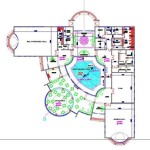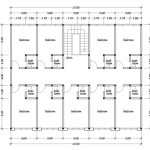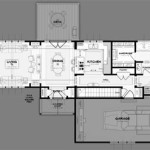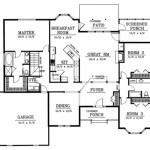House Ground Plan: Essential Elements for a Functional Home
The ground plan of a house is an essential aspect of designing a functional and comfortable living space. It lays the foundation for the overall structure and flow of the home, influencing both its aesthetic appeal and practicality. Here are some key considerations when creating a house ground plan:
1. Room Layout and Placement
The layout and placement of rooms are crucial for efficient space planning. Consider the relationship between different rooms, ensuring seamless transitions and minimizing wasted space. Open floor plans are popular for their spaciousness, while more traditional closed-floor plans offer privacy and sound insulation.
2. Natural Light and Ventilation
Natural light and cross-ventilation are essential for creating a healthy and comfortable living environment. Position windows and doors strategically to maximize daylight while controlling heat gain. Consider using skylights to bring in natural light to darker areas of the house.
3. Kitchen Design
The kitchen is often considered the heart of the home. Plan a functional layout that optimizes food preparation, storage, and cleanup. Consider the placement of major appliances, such as the stove, sink, and refrigerator, to create an efficient work triangle.
4. Bathroom Design
Bathrooms should be designed for functionality and convenience. Plan for adequate space for fixtures, such as the toilet, sink, and shower, ensuring comfortable movement. Consider the use of natural light and ventilation to promote a healthy environment.
5. Storage Spaces
Adequate storage is essential for maintaining a clutter-free and organized home. Plan for built-in storage spaces, such as closets, pantries, and cabinets, to accommodate various items and reduce the need for bulky furniture.
6. Staircases and Circulation
Staircases are an important consideration in multi-story homes. Plan for a safe and visually appealing staircase that provides easy access between floors. Allow for adequate headroom and ensure proper lighting and ventilation.
7. Outdoor Spaces
The ground plan should also incorporate outdoor spaces, such as patios, decks, or balconies. These areas extend the living space and provide opportunities for relaxation, entertainment, and al fresco dining.
8. Flexibility and Scalability
Consider the future needs of your family when designing the ground plan. Allow for flexibility by incorporating multipurpose rooms that can be adapted to changing requirements. Consider the possibility of future extensions or renovations.
9. Orientation and Sun Path
The orientation of the house plays a significant role in its energy efficiency. Plan the layout of the rooms to take advantage of passive solar heating in colder climates and shade in warmer areas. This can reduce energy consumption for heating and cooling.
10. Architectural Style and Aesthetics
The ground plan should reflect the desired architectural style and aesthetic of the home. The layout, proportions, and shape of rooms determine the character and overall feel of the house.
Creating a well-planned house ground plan is a complex task that requires careful consideration of functional, aesthetic, and environmental aspects. By following these essential principles, you can design a home that meets your needs and enhances your quality of life.

Floor Plans Types Symbols Examples

Floor Plans Types Symbols Examples

Morning Star Farm House Plan Narrow Archival Designs

Modern Style House Plan 7561 Joshua 2

House Plan Morningside Court Sater Design Collection

Floor Plans Types Symbols Examples

Where You Can Buy House Plans Live Home 3d

Grand Ridge House Plan A Classic Design Archival Designs

Truoba 320 3 Bedroom Mid Century Modern House Plan

Small House Plan Ideas To See More Visit Design Plans Little








